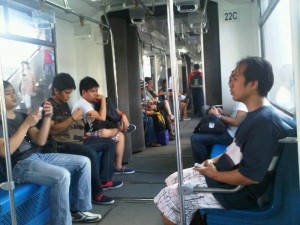Gov’t to buy out MRT 3 owners

An MRT 3 train waits for more passengers at the starting station in Pasay City on Oct. 20,2012. The government is preparing to take over the MRT line 3 as it draws up plans to buy out private groups invested in the commuter train system. PHOTO BY RICK ALBERTO
The government is preparing to take over the Metro Rail Transit (MRT) line 3 as it draws up plans to buy out private groups invested in the commuter train system.
The Department of Transportation and Communications (DOTC) said a state takeover of the train line would result in billions of pesos in savings for taxpayers, who provide subsidies mainly to cover the 15-percent return on investment guaranteed to the MRT’s privately controlled concessionaire.
“It has been brought to the President and all agencies involved agree with the proposal,” newly installed Transportation Secretary Jose Emilio “Jun” Abaya said in a press briefing on Monday.
In 2003, the MRT line’s private concessionaire MRT Corp., then owned by the Sobrepeña family, decided to cash in on its investment in the train line by issuing asset-backed bonds for future equity rental payments.
The MRT bonds, issued through special purpose vehicle MRT III Funding Corp., were acquired by private corporations. These bonds were bought back by the government through the state-run Development Bank of the Philippines and Land Bank of the Philippines in 2008.
Article continues after this advertisementAs a result, the government now owns around 80 percent of the economic interests in MRT Corp. even though “its presence is not felt in the board,” Abaya said.
Article continues after this advertisementMRT Corp. is controlled by Metro Pacific Investments Corp., the listed holding company in the Philippines of the Hong Kong-based First Pacific group.
Abaya said the government found the 15-percent guaranteed ROI too high. “The only issue raised by former (transportation) secretary Mar Roxas was that the buyout might whitewash the sins of the past,” Abaya said, referring to the decision made under the previous administration to buy only the economic rights in the train line without the accompanying political interests on the company’s board.
Abaya said the DOTC would ensure that those responsible for approving the transaction would be held accountable.
Once completed, the buyout would give the government more flexibility to do what it wanted for the MRT train line. The MRT, running on Edsa from Taft Avenue to North Avenue, carries 540,000 passengers a day. This is over the original design capacity of 350,000 passengers.
The department has yet to come up with an estimate as to how much the buyout would cost for the government, Abaya said.
The government pays about P7 billion a year to subsidize the MRT’s operations.
Abaya added that once the buyout has been completed, the government planned to eventually bid out a separate contract for the operations and maintenance (O&M) of the MRT. “Privatizing the O&M is still the DOTC’s policy. We still feel that people are better off having the private sector handling operations,” he said.